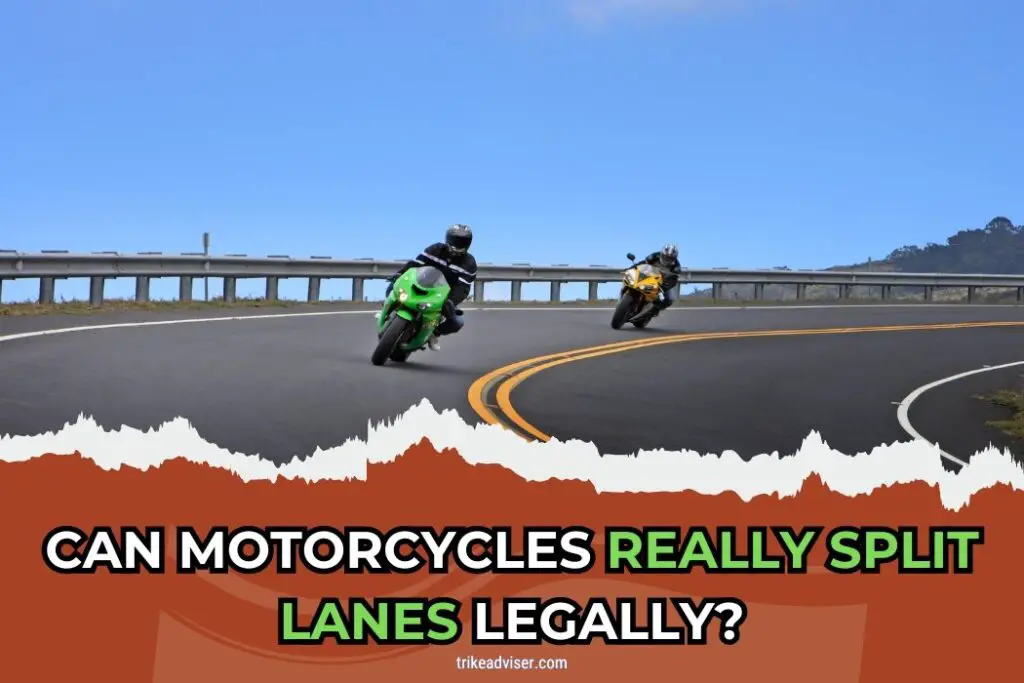Can motorcycles really split lanes legally? It’s a question that puzzles many. You’re cruising down the freeway. Traffic is crawling. Then, a motorcycle zips by between lanes. Legal? Maybe.
This practice, known as lane splitting, is a gray area in many places. Laws vary widely. Some riders swear by it for safety and efficiency. Others see it as risky.
Are you often stuck in traffic, watching motorcycles weave through? Ever wondered if you could do the same? The answer isn’t simple.
It depends on where you are, and sometimes, who you ask. Understanding the rules is crucial. This guide aims to clear the confusion. Whether you’re a rider or a driver, knowing could change your commute.
Can Motorcycles REALLY Split Lanes Legally? (Let’s Find Out)
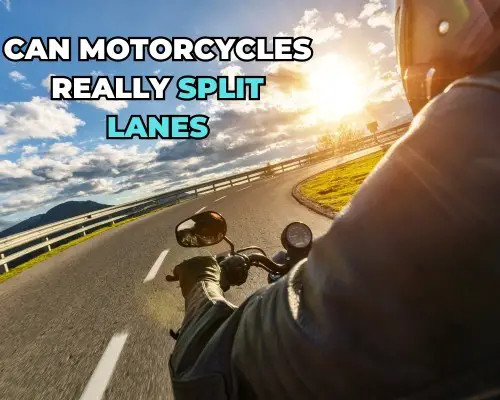
The Legality Landscape
Motorcycles weaving through traffic, a sight common in California, raises eyebrows elsewhere. Why?
The practice, known as lane splitting, varies by location. In California, it’s legal, and governed by clear rules. Elsewhere, it’s a ticket-able offense.
Lane splitting, or “white lining,” lets motorcycles navigate between lanes, usually the first and second. This maneuver helps riders avoid congestion, potentially safer than traditional lane riding.
California: A Lane-Splitting Haven
In the Golden State, lane splitting isn’t just permitted; it’s defined by law. The definition? Riding a motorcycle with two wheels in between rows of stopped or moving vehicles, on any road.
This rule applies to both divided and undivided streets and highways. California’s approach aims to streamline traffic flow and enhance rider safety.
However, motorcyclists must adhere to guidelines from the California Motorcyclist Safety Program. These cover lane width, vehicle size, weather conditions, and speed differentials.
Beyond California: A Mixed Bag
Most states frown upon lane splitting, sanctioning it with fines or penalties. But, there’s a twist. States like Arizona, Montana, and Utah allow lane filtering or shoulder surfing under specific conditions.
Lane filtering lets motorcycles move between stopped cars at intersections, a boon during traffic jams. Shoulder surfing, albeit rare, involves riding on the shoulder during congestion.
The Gray Areas
In some states, the legality of lane splitting hangs in ambiguity. Laws don’t directly address it, implying legality by omission.
However, this gray area doesn’t guarantee safety from legal repercussions. The absence of explicit prohibition isn’t a green light for riders. It underscores the importance of knowing local laws and exercising caution.
Key Considerations
For motorcyclists, especially in California, understanding the fine print is vital. The California Motorcyclist Safety Program’s guidelines are a must-read.
They emphasize practical aspects like lane width, surrounding vehicle sizes, and weather conditions. Moreover, the risks increase with greater speed differences between motorcycles and other vehicles.
Awareness and adherence to these guidelines can make lane splitting both safe and legal.
The Legality of Lane Splitting – A Global Perspective
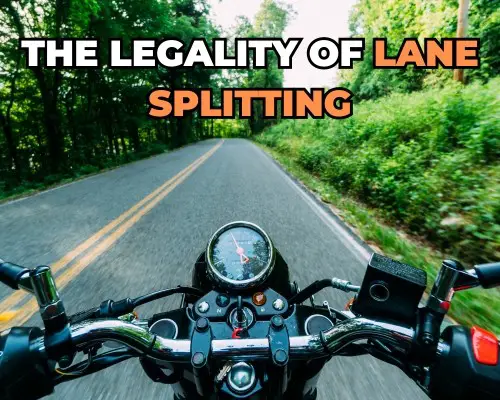
Lane Splitting Laws Around the World
Riding between lanes, known as lane splitting, lane filtering, or white lining, varies in legality across continents, shaping daily commutes and motorcyclist behavior. Let’s dive into how different cultures handle this intriguing practice.
Europe: A Diverse Landscape
- Germany: Here, it’s a tactical maneuver, legal only when traffic crawls or halts. Imagine the Autobahn; it’s practically a necessity.
- France: The law might not nod yes, but if you’re riding in Paris, you’ll see bikes slipping through traffic jams, all under the forgiving eyes of local law enforcement.
- Netherlands, Spain, Italy: More than just legal, it’s an unspoken rule of the road. Motorcyclists and drivers see it as a mutual aid in the battle against congestion.
- United Kingdom: It’s a bit cheeky here. Not outright legal, but go on any major road, and you’ll see motorcycles filtering through, especially where the speed hits 70 km/h.
North America: Varied Acceptance
- United States: Mostly a no-go, with California standing out as a proud exception. Here, it’s not just allowed; it’s embraced with clear-cut rules to protect all road users.
- Canada: Forget about it. If you’re caught splitting lanes, you’re in for a rough ride with the authorities.
Asia and Australia: Complex Regulations
- Australia: A hot topic down under. Each state has its take, making it a patchwork of regulations that spark heated debates among riders.
- Philippines: Officially a no, but unofficially? It’s how many riders cope with Manila’s legendary traffic snarls.
- Poland: It’s a gray area. No laws specifically ban it, but it’s not in the clear either. It depends largely on where you are and who’s watching.
Case Studies: Where Lane Splitting Thrives
Case Study: Spain
- Background: Accepted and advocated. It’s part of the driving culture, deeply embedded in daily traffic flow.
- Impact: Research shows lane splitting in cities like Madrid reduces commute times by up to 40%. It’s a significant figure that highlights efficiency.
- Public Perception: Overwhelmingly positive. It’s seen as a sensible solution to a common problem. Both riders and drivers acknowledge that it keeps traffic moving.
Case Study: California, USA
- Background: A beacon for lane-splitting advocates across the U.S.
- Regulations: Governed by specific rules—speed limits, traffic conditions, and even the skill level of the rider are all considered to ensure safety.
- Outcome: Studies by the California Highway Patrol show a drop in motorcycle-related accidents where lane splitting is practiced. It’s a testament to the practice’s safety when regulated properly.
Lane splitting is an interesting example of how culture, law, and pragmatism interact. It’s frequently hailed as a victory of common sense in urban design in areas where it’s legal.
Where it’s prohibited, you may hear commuters frustrated by never-ending gridlock complaining. It’s not just good practice to be aware of the subtleties of local legislation; it’s a must for riding safely and ethically in foreign countries.
Knowing these laws isn’t simply academic; they could define your ride, whether you’re riding legally in Toronto or navigating through Rome.
The Impact of Lane Splitting on Traffic Flow
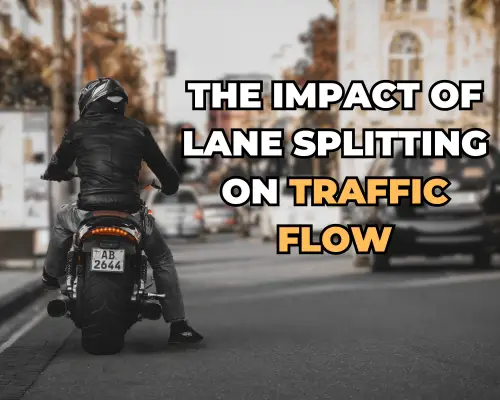
Analyzing Traffic Congestion Reduction
Lane splitting, often referred to as lane filtering, acts as a subtle but powerful tool in the fight against urban traffic jams.
By weaving through congested lanes, motorcyclists not only expedite their travel but significantly lighten the load for everyone on the road.
- Enhanced Flow: Traffic is a slow-moving beast, cars lined up with no end in sight. Now, here comes a motorcyclist, gliding effortlessly between lanes, bypassing the gridlock that traps four-wheeled vehicles.
This isn’t just a trick to beat the jam; it’s a practical solution that breathes a bit of movement into choked traffic veins.
- Statistical Support: Consider the findings from a Belgian study in 2012. It revealed that if merely 10% of drivers switched to motorcycles and adopted lane filtering, the overall travel times for car drivers could be reduced by a notable eight minutes per journey.
This isn’t just a slight improvement—it’s a transformation that could revolutionize morning commutes.
Potential Challenges and Negative Perceptions
While lane splitting offers clear benefits, it’s not without its hurdles and is often misunderstood by those who stick to four wheels.
- Safety Risks: Lane splitting is akin to a high-wire act—it requires precision, balance, and acute awareness of one’s surroundings.
The spaces between cars are narrow, the room for error minimal, and the consequences of a misjudgment are potentially severe.
- Public Perception: Not everyone sees lane splitting as fair play. To some car drivers, it feels like cutting in line, which can stir up frustration and even provoke aggressive responses. This can erode the mutual respect necessary for shared road use.
Positive Impact on Safety: A Closer Look
Beyond easing traffic, lane splitting might serve as a safeguard for motorcyclists under the right conditions.
- Research from the University of California, Berkeley (2015): Some strong findings came from this important study. Rear-ending motorcycle riders were less than half as often among those who split lanes as it was among those who rode inside lane boundaries.
In particular, the incidence rate for lane splitters was 2.6% whereas the rate for non-splitters was 4.6%.
This indicates that lane splitting when executed correctly, could indeed mitigate certain crash risks.
Adding a Personal Touch: Expert Tips for Safe Lane Splitting
To harness the benefits of lane splitting without falling prey to its risks, consider these expert tips:
- Stay Visible: Wear high-visibility clothing and use lights even during the day. Making sure you’re seen is half the battle in safe lane splitting.
- Mind the Speed: Maintain a speed that is only slightly faster than the surrounding traffic. The greater the speed differential, the higher the risk.
- Anticipate Movements: Always anticipate possible movements from cars around you. Look for signs like turning wheels or drivers checking mirrors, which suggest a lane change might be imminent.
- Be Courteous: Remember, lane splitting is as much about psychology as it is about physical space. Acknowledge drivers who make room for you. A simple nod or a wave can go a long way in fostering goodwill.
Motorcycle Lane Splitting Done Right – Stay Safe on the Road
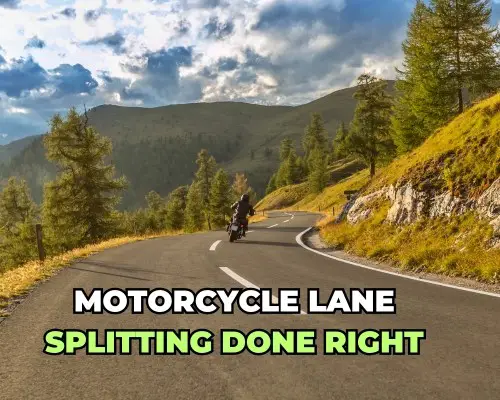
Stay Aware and Alert
Lane splitting is not just about sliding between cars—it’s a full-sensory engagement with the bustling world of the road.
- Scan Constantly: Imagine you’re the conductor of an orchestra where every vehicle is an instrument. You need to anticipate the next note—whether it’s a car drifting into your lane or a door swinging open.
- Expect the Unexpected: Just as I once thought a neatly packed duffle wouldn’t exceed the weight limit, you might assume drivers see you. Often, they don’t. Assume invisibility as your default state and ride with the extra caution this mindset necessitates.
Maintain a Safe Speed
Speed is your ally and enemy when lane splitting—managing it correctly can mean the difference between a smooth ride and a close call.
- Speed Differential: Stick to the 10-mph rule over surrounding traffic not just as a guideline, but as a buffer zone for safety. It gives you enough reaction time without making you a bullet through traffic.
- Slow Down in Doubt: Ever had that gut feeling to double-check if the stove was turned off before leaving the house? Apply that same principle here. If something feels off, slow down. Better safe and slightly delayed than fast and in danger.
Visibility is Key
Being seen can be as critical as your motorcycle’s brakes.
- High-Visibility Gear: Wear gear that screams to be seen. Think fluorescent, reflective, and lit up like a Christmas tree. It’s not just about style; it’s about being spotted from a mile away.
- Use Your Lights: Day or night, your lights can catch the eye of a distracted driver, perhaps pulling them back just in time to notice you.
- Avoid Blind Spots: Stay clear of the no-man’s-land beside and just behind cars. If you linger there, you might as well be invisible.
Wise Lane Choices
Choosing where to split lanes is as strategic as choosing which battles to fight.
- Preferred Lanes: The lanes you choose should offer escape routes. Think of the leftmost lanes as your main arteries—they usually provide more room to maneuver.
- Be Cautious Around Large Vehicles: Large vehicles are like beasts in a forest; approach with respect and keep your distance. Their blind spots are your danger zones.
Exercise Good Judgment
Your judgment is the best tool you carry. Sharpen it every ride.
- Assess Conditions: Just as you might check the weather before a picnic, assess traffic conditions before deciding to split lanes. Adapt your strategy to what the road presents.
- Trust Your Gut: If today feels off, or if the traffic is too erratic, listen to that inner voice. There’s no shame in taking a step back. Safety is personal, and sometimes, patience truly is a virtue.
Proper Gear and Maintenance
Your gear is your armor and your chariot needs to be battle-ready.
- Protective Clothing: Suit up as if you’re heading into battle. Full-face helmet, armored jacket, gloves, and boots—these are your shields.
- Bike Readiness: Like checking your ship before sailing, ensure your bike is sea-worthy. Brakes sharp, tires firm, lights bright. This isn’t just maintenance; it’s your lifeline.
Stay Focused
The art of lane splitting requires the focus of a master craftsman.
- Concentrate Fully: Each moment on the road should have your full attention. Let distractions fall away as you tune in to the rhythm of the traffic and the dance of your bike.
- Avoid Distractions: Keep your mental space clear. No phones, no deep daydreams. Keep your thoughts on the road and your eyes on the prize—safe arrival.
- Recognize Your Limits: We all have days when we’re not at our best. Recognize yours. If you’re not feeling sharp, choose a safer route, or park the bike for the day.
As an Amazon Associate, I earn from qualifying purchases, at no additional cost to you. Read Our Affiliate Disclosure.

